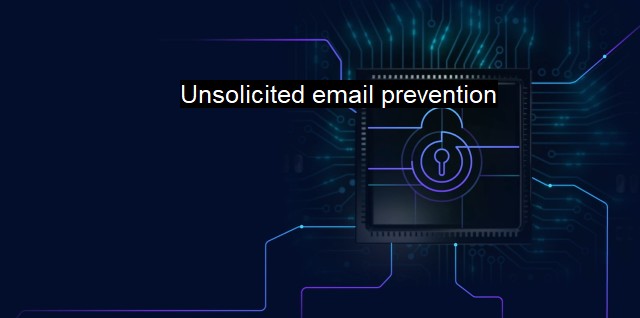What is Unsolicited email prevention?
Shielding Your Inbox: The Vitality of Unsolicited Email Prevention in Cybersecurity and Data Protection
Unsolicited email, more commonly known as spam, refers to unwanted or junk email messages sent over the internet. Often filled with fraudulent activity, schemes, and malware, these emails present a significant concern for individual users, businesses, and organizations alike. Amid this backdrop, unsolicited email prevention has emerged as a highly crucial aspect in the realm of cybersecurity and antivirus protocols.Emails have been a major communication channel for several decades now, and they remain a crucial tool for both personal and business correspondence. the increasing influx of unsolicited emails threatens to engulf users in a sea of junk mail, making it exponentially more challenging to spot important messages. More alarmingly, unsolicited emails often carry dangerous payloads of ransomware, viruses, and other cyberthreats intended to compromise an individual or organization's digital security. This is where the importance of unsolicited email prevention comes to the fore.
Unsolicited email prevention is primarily aimed at shielding email users from these kind of threats. Various measures constitute this effort, with anti-spam filters being the groundwork. Anti-spam filters make use of pre-established rules and algorithms to scrutinize incoming emails, evaluating them on the basis of various factors such as the sender's reputation, the email's content, headers, and numerous other parameters. For instance, emails from unknown senders or those with suspicious attachments or URLs are most likely to be labeled as spam and sent directly to the spam or junk folder.
Another effective tool for unsolicited email prevention is the antivirus software. Besides scanning computer systems for potential threats, most antivirus software today also come with integrated email scanning capabilities. With every single email being rigorously vetted by the antivirus program, the threat posed by potential malware hidden in unsolicited emails can be appropriately mitigated.
Yet another decisive measure lies in user training. Given the evolving nature of cyber threats, it's imperative to focus on educating email users about the relevance and modus operandi of unsolicited emails, phishing attacks, and other such online scams. Knowing how to unravel suspicious emails, links, and attachments; understanding the significance of safe browsing and software patching; and the value of utilizing strong, unique passwords – all contribute to forming a robust first line of digital defense against unsolicited emails.
In a more technical vein, authentication protocols like Sender Policy Framework (SPF), DomainKeys Identified Mail (DKIM), and Domain-Based Message Authentication Reporting and Conformance (DMARC) are being increasingly utilized to counteract spam emails. These protocols add a layer of legitimacy to the sender's domain, cutting down the likelihood of fraudulent or unsolicited emails reaching the recipient's inbox.
While the measures used for unsolicited email prevention are varied and extensive, a key attribute they share is the dynamic responsiveness to the changing digital environment. With phishing schemes growing more complex and cybercriminals seeking to exploit even the tiniest cracks in cybersecurity measures, unsolicited email prevention remains an ongoing effort necessitating constant updates to the precautionary procedures.
Unsolicited email prevention is not only a singular action but an amalgamation of various tactics designed with one goal: protecting email users from the cyber risks associated with unsolicited emails. Given the ongoing proliferation and evolution of cyber threats, this aspect of cybersecurity and antivirus measures will continue to demand significant attention and warrant constant improvement.

Unsolicited email prevention FAQs
What is unsolicited email and why is it important to prevent it for cybersecurity?
Unsolicited email, also known as spam, is unwanted or irrelevant email messages sent to a large number of recipients without consent. Cybercriminals use spam emails to spread malicious content such as viruses, malware, and phishing scams. Preventing unsolicited email is critical for cybersecurity because it helps to reduce the risk of cyber-attacks and protect sensitive data.What are effective ways to prevent unsolicited emails?
Effective ways to prevent unsolicited emails include using spam filters, avoiding opening suspicious attachments or links, not responding to spammers, and using a reputable antivirus software. Additionally, never share your email address on untrusted websites and configure your email settings to block or move spam messages to the spam folder.What are some common signs of unsolicited emails?
Some common signs of unsolicited emails include receiving emails from unfamiliar senders, emails with a generic greeting, misspelled words, or poor grammar. Additionally, unsolicited emails often include suspicious attachments or links, requests for personal information or financial details, and urgent or threatening language.What measures can individuals and organizations take to safeguard themselves against unsolicited emails and other cyber threats?
Individuals and organizations can take several measures to safeguard themselves against unsolicited emails and other cyber threats. These measures include regularly updating software and operating systems, using strong passwords, avoiding public Wi-Fi networks, enabling multi-factor authentication, and educating employees on how to identify and report cyber threats. Additionally, organizations can implement a cybersecurity policy and conduct regular security assessments to identify vulnerabilities and address them proactively.| | A | | | B | | | C | | | D | | | E | | | F | | | G | | | H | | | I | | | J | | | K | | | L | | | M | |
| | N | | | O | | | P | | | Q | | | R | | | S | | | T | | | U | | | V | | | W | | | X | | | Y | | | Z | |
| | 1 | | | 2 | | | 3 | | | 4 | | | 7 | | | 8 | | |||||||